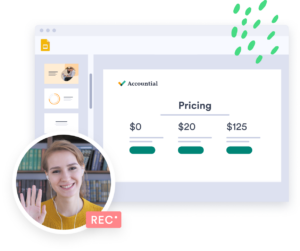Sales enablement plays a crucial role in any successful sales organization. Learn why and the sales enablement best practices you need to help your sellers be more successful.
Sales enablement is the advocate, teacher, and behind-the-scenes supporter of sales teams. Their singular focus is to anticipate the needs of sellers so they can do what they do best: close deals. Because there are endless strategies to achieve this, I’ve narrowed them down to the four most important sales enablement best practices—content curation, partnerships, early collaboration, and continuous improvement.
In this article, I’ll define the function of sales enablement—what we do and why we do it—and how to help your sellers succeed. We’ll wrap up by explaining the foundational role video plays in sales enablement strategies and why I wouldn’t build a sales team without it.

 Record and send video messages to help enable your sales team. Get it Free
Record and send video messages to help enable your sales team. Get it Free - Contents
- 1. What Is Sales Enablement?
- 1.1 Curating Resources
- 1.2 Anticipating Needs
- 1.3 Continuous Improvement
- 2. The Top 4 Sales Enablement Best Practices
- 2.1 Curate Sales Enablement Tools and Resources (Instead of Collecting)
- 2.2 Prioritize Engagement With Sales Leadership
- 2.3 Partner Early With Your Internal Teams
- 2.4 Teach, Repeat, and Iterate on Your Sales Enablement Strategies
- 2.5 Bonus: Include Video in Your Sales Enablement Best Practices
- 3. The Sales Enablement Team Is the Seller’s Advocate
What Is Sales Enablement?
Simply put, sales enablement is the process of providing your sales teams with the support they need to close more deals. That process is defined by three core activities:
1. Curating Resources
The goal of the sales enablement team is to ensure their teams have all the knowledge, skills, processes, tools, and technology they need to grow and sell. To that end, sales enablement teams are always curating the information they receive—product changes, marketing language, new resources—to align with the needs of their sales teams.
They are collaborating with sales leaders, marketing, and product teams to understand how the business is changing before presenting that knowledge to their sales teams. It’s a constant negotiation of taking in information and packaging it in the language, format, and channel that sales folks will find the most valuable. Everything sales needs to succeed should be easy to find and easy to use.
2. Anticipating Needs
Your sales enablement strategies should include close collaboration with internal leaders to ensure that you all have a finger on the pulse of the organization’s goals. Ideally, the sales enablement team is in Slack channels—analyzing the common issues and questions that come up—proactively considering solutions and resources that would make sellers’ lives easier. From there, the enablement team can also advocate on behalf of sellers to their leaders and bring to their attention the knowledge gaps that should be filled.
Great sales enablement teams are always proactively and thoughtfully advocating for the needs of their customers—the sales teams.
3. Continuous Improvement
The sales enablement team also operates on a continuous improvement cycle. They’re always analyzing their knowledge, processes, and tools to determine how they can be further optimized. Continuous improvement could include improving the design of sales resources, engaging in change management, sales coaching, and completing gap analysis.
Continuous improvement also affects the onboarding of new sellers. The sales enablement team is constantly considering whether their onboarding and training equip new sellers with the information they need to succeed. They are always iterating on that training by identifying the gaps that emerge as those sellers settle into their roles.
It’s the sales enablement team’s job to curate sales resources, anticipate needs, and constantly improve the knowledge, processes, and tools that sales need to succeed.
The Top 4 Sales Enablement Best Practices
What defines a good sales enablement strategy is your team’s ability to be observant and proactive. If your sales enablement team isn’t embodying these best practices, they are likely being reactive to the needs of their sellers, not proactive.
1. Curate Sales Enablement Tools and Resources (Instead of Collecting)
One of the worst things a company can do is build sales enablement tools and continually add content as if constructing a museum of sales wisdom. If the success of your sales enablement strategies is defined by how well you can equip sellers with the resources they need to close deals, continually adding (and never subtracting from) a library of training videos, slide decks, whitepapers, and guides will quickly become overwhelming.
Instead, opt to be a content curator—adding, replacing, refining, and iterating on the most effective resources for each team, funnel stage or topic. Organize your sales enablement tools in easily accessible shared drives or internal sites. Determine how those resources should be best categorized (by team, product, content type, etc.). Then identify who’s responsible for keeping them updated.
Build content curation principles and stick to them. Don’t build more resources or add more documents until you modify, revamp, and change what you already have. In content curation, fewer, higher-value pieces of content are more effective than many pieces that are only mildly interesting.
This approach to resource management keeps the best resources top of mind and elicits trust from sales teams. They always know that whatever they’re accessing is the most valuable and relevant to them.
2. Prioritize Engagement With Sales Leadership
Sales enablement teams and sales leaders are working towards the same end: more successful sellers. That’s why it’s imperative that your sales enablement strategies are aligned with sales leadership to offer the same valuable, relevant resources. This is achieved through regular check-ins with leaders. Offering new content, asking about key challenges sellers are facing, and planning ongoing training and support.
This is also a great opportunity to advocate on behalf of sellers about their challenges. If you’re noticing the same issues come up over and over in training or team meetings, these sales leadership check-ins are the time to make your concerns and solutions known.
If the sales enablement team doesn’t have a solid understanding of what sellers are experiencing day to day, they cannot support the guides, how-tos, and demos sales folks need. And if the sales enablement team doesn’t have a strong partnership with sales leadership (and internal teams, as we’ll discuss), then they’re reactive rather than proactive to the needs of sales.
3. Partner Early With Your Internal Teams
Speaking of staying proactive, sales enablement’s collaboration with internal teams like marketing, customer experience (CX), and product are important to create the resources sellers need.
The product team is the expert on what you’re selling, marketing creates the demand, and CX knows how to talk to your customers. By collaborating on the early stages of sales enablement tools and resources, you’re able to create resources that draw from each team’s unique value. Your job in sales enablement is then to translate that knowledge and value into the most effective content for sales.
Instead of working separately—playing tag with content until it slowly morphs into something useful—you should iterate together to create messaging efficiently. The sales enablement team may not know content writing, but they know how salespeople prefer to learn, what they need at each stage, and where they go for information. Executing all that is much faster when sales enablement and internal teams partner together early on.
I see the success of early collaboration in leading my own go-to-market (GTM) enablement and CX operations team. Sales and CX enablement are actually working together and complementing each other—often ensuring both teams share information or help each other arrive at creative solutions they wouldn’t have otherwise. They’re also able to work faster by sharing projects and templates instead of starting from scratch. The value of strong internal partnerships is exceptionally high—whether that’s sharing resources or executing projects faster.
4. Teach, Repeat, and Iterate on Your Sales Enablement Strategies
Your processes are likely to change—shifting to align with new business strategies, your industry, your sales environment, or new sales tools. Successful sales enablement teams are always offering new (or old) wisdom. They’re also finding ways to resurrect resources to keep everyone sharp, and striving to enhance and re-develop processes.
To that end, effective sales enablement teams look for creative avenues to deliver and repeat critical information. My team often employs “resource spotlights” in our regular sales meetings. We use these to remind the team of helpful content they may not remember exists. That’s possible because of our focus on content curation. Those spotlights can be extremely practical, with the presentation of a resource along with a video example of someone using it on a customer call.
If your team hasn’t “curated” your content yet, identifying those gaps will also reveal how your sales enablement strategy could be improved. A commitment to continuous improvement should inspire your team to seek out resource gaps and internal feedback. Build a sales enablement team that doesn’t fear failure or change but instead embraces it as an opportunity to improve.
Leaders in sales enablement share their tips and secrets to get your sales teams onboard with new technology.

Bonus: Include Video in Your Sales Enablement Best Practices
Sales enablement teams should be using video. I don’t say that lightly. There are four major use cases for video that are essential to the function of a sales enablement strategy.
- Communicate. Update teams on process, product, and business changes with asynchronous video. Video helps sales enablement teams regularly and easily communicate must-watch updates.
- Build. Create educational, onboarding, and training videos. Curate all videos on a centralized hub [like Vidyard] which is organized by helpful, editable categories.
- Capture. Share sales wins, best practices, and FAQs. Collect examples of excellent sales calls and use them to continually improve your sales enablement training.
- Innovate. Use video to enhance storytelling and sales engagement. Host live pitch competitions and async team-building activities.
Whether they’re an experienced rep or a new hire, video sales enablement resources can be immensely helpful, engaging, and memorable. Don’t underestimate the power of video to equip your sales team.

 Record and send video messages to help enable your sales team. Get it Free
Record and send video messages to help enable your sales team. Get it Free The Sales Enablement Team Is the Seller’s Advocate
All the behind-the-scenes work of the enablement team is in service to sales and their success. Any sales enablement best practices should lead your team towards that goal. Whether it’s curating video content, partnering with sales leaders, collaborating with internal teams, or improving processes. It’s time to become an expert on your customer—sales.



More Stories
Visionary Branding in the Middle District, Integrating Consulting and Digital Innovation
Business News Stories Making Headlines
Breaking Business News You Should Know Today